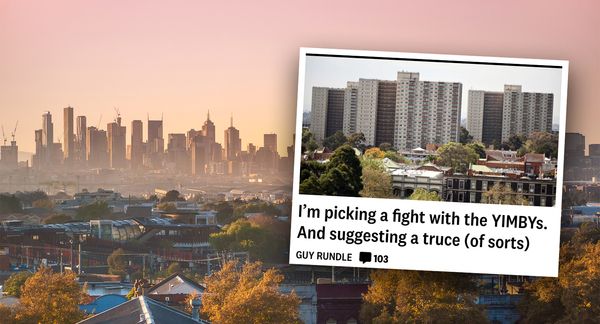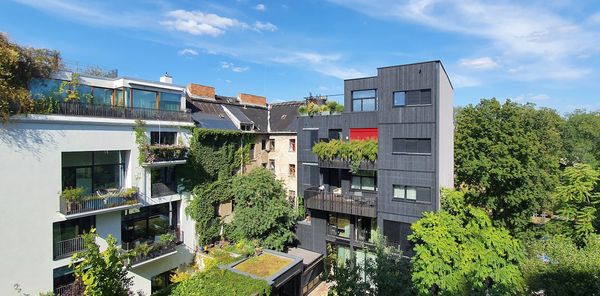
The recent budget has indicated the housing and renting crisis will continue. No big changes, no surprises, a derisory amount of rent relief for a minority. We need major public building programs and rent caps, and we won’t get them. But before we swing our guns back to that, some of us have had to have an “internal struggle”, as it were, with the YIMBYs.
Why prioritise the fight against the “Yes In My BackYarders”, when they’re pushing for what’s desperately needed? For me, it’s because they’ve set their sights firmly on the destruction of the 19th- and early 20th-century core of our cities.
The YIMBYs’ disdain for these magnificent, beautiful, culturally unique areas that we have managed to save from mass demolition and freeways is nihilism pure and simple. Were you to combine their appetite for destruction with the desire for fast-track approvals, you would get an inner city of dreary, grey, concrete, featureless slab-tilt, with a few shops on the ground floor.
This nihilistic drive is matched by proposals based on spurious right-wing economic theory, that the lack of new housing stock is the product of over-regulation. This is based on a fairytale that demand and supply will always find each other, and that an increase in the ease of providing the latter will drive down the price of the former.
The obvious answer to that, in the case of land and housing, is that the steady increase in demand and price increases the selective incentive to not build if you own the land. Why? Because the land increases in value without developing it, at zero cost and zero risk.
While that eventually feeds back — if everyone stopped building, the profits for anyone who did would be vast — the “land banking” that results from the current arrangements effectively acts as the main drag on development.
This is conceivably made worse, not better, by fast-track permit approvals. For the price of getting a permit, the value of “permit approved” land goes up markedly. No real issue with the risks of labour, supplies, disasters, or of actual building. Thus the result The Age revealed last month: there are thousands of approved development permits not being used.
Much of the YIMBY energy in Melbourne has come from Brunswick, much of it involving cherry-picked stories of a council refusing permits to developers trying to push the precedent envelope. But this and every council has a 90% or so permit approval rate, and VCAT has a 70% pro-permit result.
Brunswick is stuffed to the gills with new apartment builds. Its numerous, old brownfield industrial sites still lying undeveloped are due to market calculations by owners, not permit snarl-ups. No-one can really look around the streets of concrete that have developed there in the past decade and say that development has been slow.
The YIMBYs don’t talk about this, because they can’t. It doesn’t compute with what is, at its base, a Thatcherite, neoliberal, ideological belief in small government and deregulation, right-wing magical thinking that is, for whatever reason, unstintingly favourable to developers.
The evidence the YIMBYs marshall to their case is often wobbly, to say the least. For a year or so, they have spruiked the “Auckland case”, in which the city upzoned after municipal amalgamation. YIMBYs parade the Auckland example of an alleged increase in supply and lowering in rent as if it were the bones of a saint. But it’s been demolished by economist Leith van Onselen (family motto: “At Leith he’s not Peter”).
YIMBYs, if they genuinely want to force the pace of inner-city, high-density building, need to turn their attention first to lobbying for more building of public housing, with a universal and socially multidimensional profile — that is to say, we should go back into public housing for low-income and benefits tenants, but also for standard-rental tenants and build-to-sell.
The YIMBYs need more imagination, not less on this. In Melbourne, for example, old military land at Maribyrnong and old industrial inner-west land could be aggressively reoriented to government buildings for a mix of renters and buyers (using price-limited sell-back schemes, to stop speculators).
This could be a lot more audacious than the rather limited six storeys the YIMBYs propose. There’s no reason that stylish, striking, A-list architect-designed, government build-to-sell towers wouldn’t be attractive to people who want to live closer in, for affordable prices.
It’s not an overnight thing, but it should be supplemented by calls for more regulation, not less, of developers — i.e. compulsory acquisition and public build or sell-on for persistently land-banked properties. That would get things moving quite rapidly. But it requires YIMBYs to propose measures that limit developers’ rights, which, for some reason, they are loath to do.
So, the idea that we would plough through inner-city neighbourhoods for no gain except the right of developers to leave vacant lots for years — decades — on end, is ludicrous. This approach destroyed American cities, leaving them as vast arid car parks.
Stopping that requires a concerted and united effort by residents’ groups and what remains of the heritage lobby, to build their collective power against the YIMBYs, who specialise in releasing papers and getting news stories from sympathetic journalists.
Residents’ groups in inner Melbourne and Sydney need to create a new political umbrella body with pooled resources and some paid staff to match the collective YIMBY lobbying effort. They need to assert their collective power, their power to direct votes, and devote resources to refuting YIMBY myths.
But once this power has been reasserted, there needs to be some reassessment and a refashioning of the resident/heritage case. The plain fact is that YIMBYs will eventually succeed in convincing people that inner-city suburbs need to be planed flat if there is not more action to increase density in inner and inner-middle areas.
That does demand, it seems to me, a reassessment of the relationship between the historical city (“heritage” is becoming a deadened term) notions of character and amenity, and of heritage areas and the use of overlays.
The fusion of forces protecting the historical city, and the low-level scale it has dictated, has been a long one, but it may be that the preservation of large amounts of that historical city relies on less enforcement of an idea of a composed or uniform area by height, massing, materials, etc.
Put more simply, it might be necessary to imagine an inner city in which higher, narrow towers are side by side with rows of terraces and shops, as the price of retaining those. That is a quite different conception from the YIMBY one, which is to level old, single-house neighbourhoods and build six-storey, street-wall apartment blocks.
Personally, I don’t think anyone should be permitted to demolish a pre-1918 building at all, and the onus should be strongly on the demolisher in all cases to demonstrate that there is no option. But we should contemplate a different aesthetic in which, say, a 10- or 12-storey pencil tower could appear next to a terrace row.
That would allow us to combine large-scale inner-city preservation with some possibility of creating inner-city affordability — though that too requires re-, not deregulation; the YIMBY’s beloved open slather is creating reductions in dwelling numbers — though it means a certain idea of the inner-city will have to be let go. But absent a sudden, years-long free in immigration, it will have to change anyway.
That leaves later build and styles — California bungalow, Spanish mission, Tudor revival and English red-brick, Art Deco and early modern — which well, I’d ban all demolition of them too, but I won’t win that fight, especially regarding Tudor revivals.
I would suggest that some sort of new classification is required, between full heritage protection and right-to-demolish, for houses and individual buildings and street sections that note them as items of historical distinction and make preservation the default setting. There’s some of that already, but it’s pretty limited.
That brings one to the dreaded heritage overlay, and there’s no way around admitting that it has become overused and too expansive in some areas. Personally, I feel it should be total and rock solid in some areas. In Melbourne, Carlton North, Parkville, North Fitzroy, Albert Park and Middle Park, and parts of Clifton Hill and Ascot Vale, should be on the UNESCO World Heritage Register.
These are supreme intact examples not just of Victorian-Edwardian architecture, but of the distinctive Australian approach to it. The expressiveness, invention, colour, delight, surprise and variety of the boom styles, Federation styles and related styles are the equal of New Orleans, Savannah and the Italian cities they were modelled on.
But in the middle (really now middle-inner) ring of suburbs, it’s impossible to deny that the heritage overlay has become overused, and is running too far ahead of public acceptance. That is bitter to admit. I’ve been in heritage campaigns for so long now, that I can recall, as a young fogey protectionist, when overlays started to come in.
What relief! What a deep sense that the city had been held back from the abyss, that one would not have to fight building by building to retain sticks and stones. Now, having extended to the post-war era and areas, overlays are starting to scoop up areas that many people do not recognise as distinct or historical, and can sometimes promote absurdity, when they take in streets or buildings too altered to have retained character.
The answer to that would be a new middle form, areas of four blocks or so, showing strong intact character, combined with individual protections for buildings close to but outside them, but with more flexible development allowed outside those historical cores.
Once again, that further separates heritage from neighbourhood character. But it would gain the best result — areas retaining texture, character, ornament and beauty which would add to the experience of new residents drawn in by increased density.
State governments with joined-up thinking on matters like a public mental health crisis policy should understand that good urban design — which means character, texture, non-uniformity, historical continuity, all the things humans need and seek — is a mental health policy.
Evolving from political positions that were created in the 1970s is going to be a test for the historical city movement and for the wider “neighbourhood character” movement. The latter is going to have to admit that there is a social justice component to the demand for access to urban centrality. The former will eventually have to define themselves separately to a degree.
The YIMBYs are going to have to get real about what’s really preventing an affordable dwelling revolution. That may well mean something of an internal struggle as more people from the political left join them and start to question the neoliberal bias imposed by their somewhat socially disconnected founders.
It certainly means a turn away from the hate towards the historical city — most recently directed against the retention of 40 19th-century kit-houses, survivors of the thousands once in evidence as Melbourne swelled during and after the gold rush. The YIMBYs want these put in a museum, because they’re portable hahaha.
The YIMBYs currently want cities not merely planned on a spreadsheet, but resembling one, made of gray lines and numbers. Decrying the city as a museum, they propose instead the city as a mausoleum, in which we’re housed in blocks of numbered drawers. They need to reconstitute their position on the historical city and their magical thinking about the market so that a common cause on real action on affordable housing can be made.
Before and while we renovate the idea of the historical city, and until they revise their approach, every skerrick of power and influence has to be directed at the fight to defend the historical city. We, and our predecessors, conservatives and communists together, and all points between, held these back from ruin once, and we have to do it again. The struggle is unique. Bad policies and governments come and go. Once our history is gone, it’s gone. And we with it.










